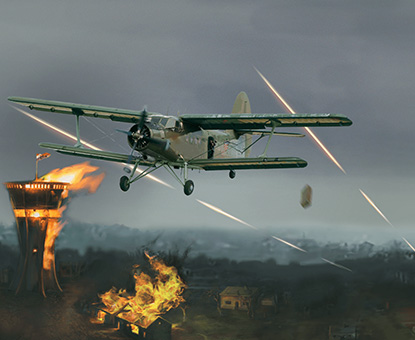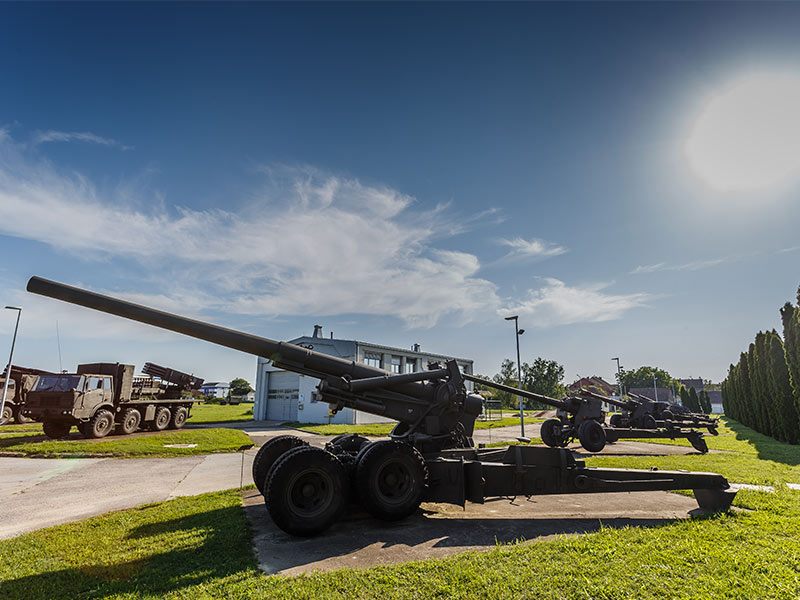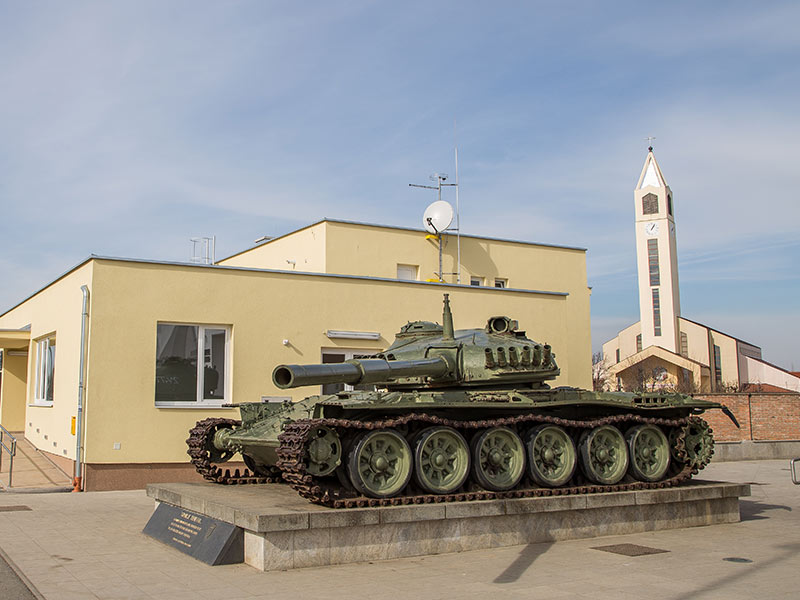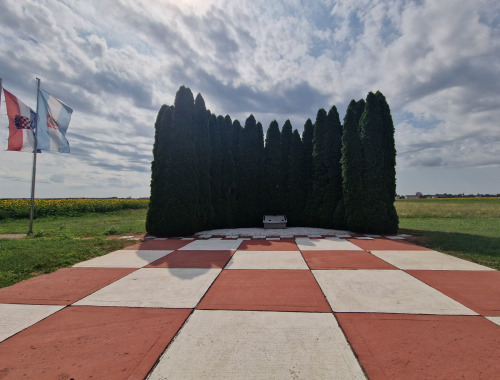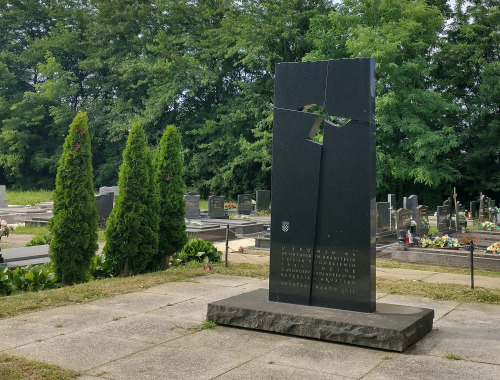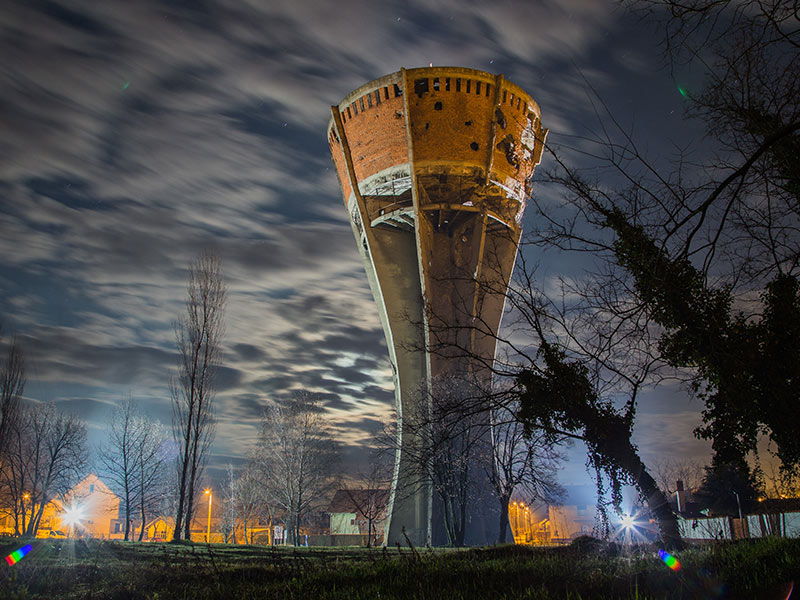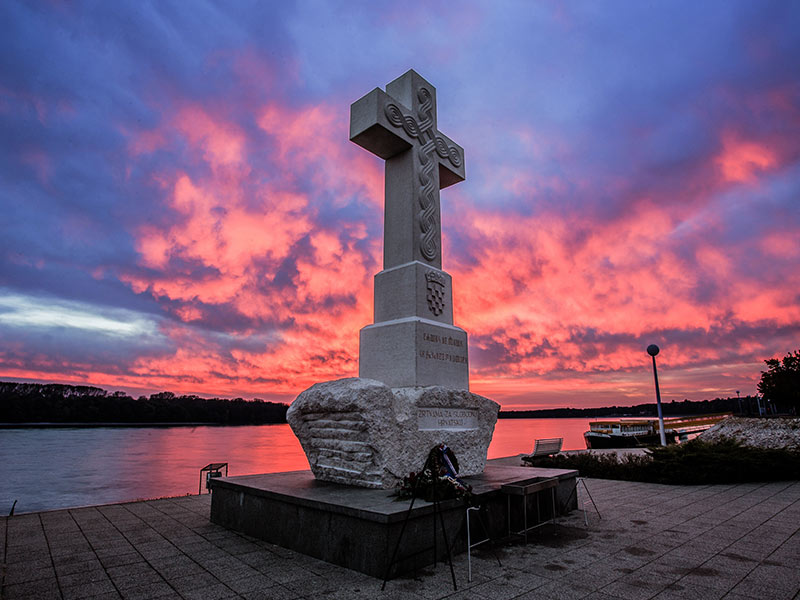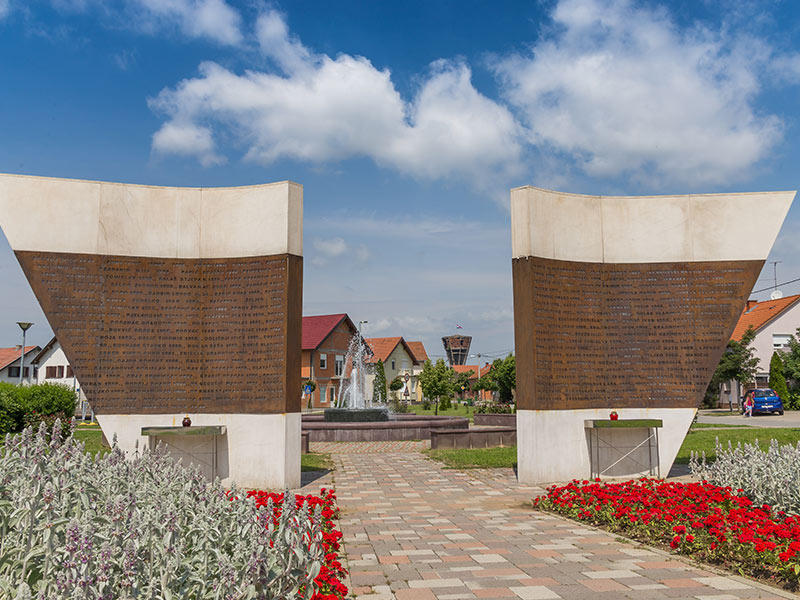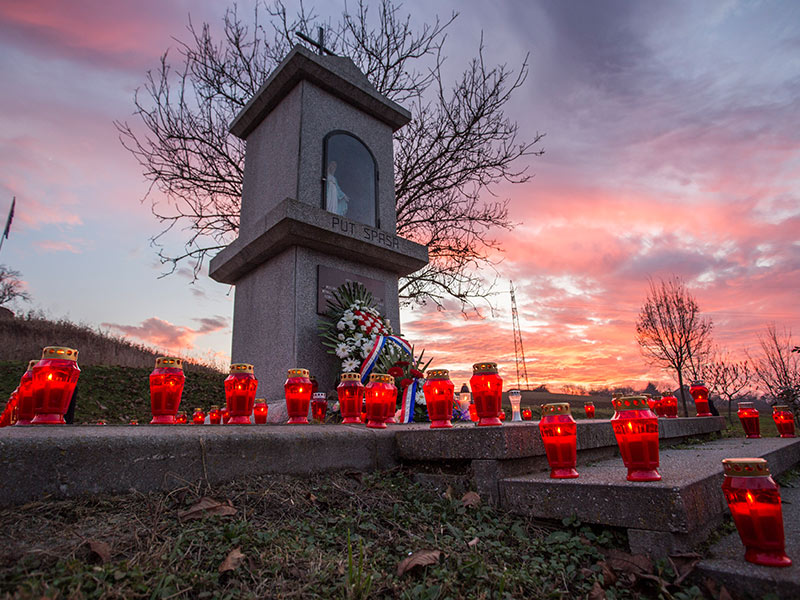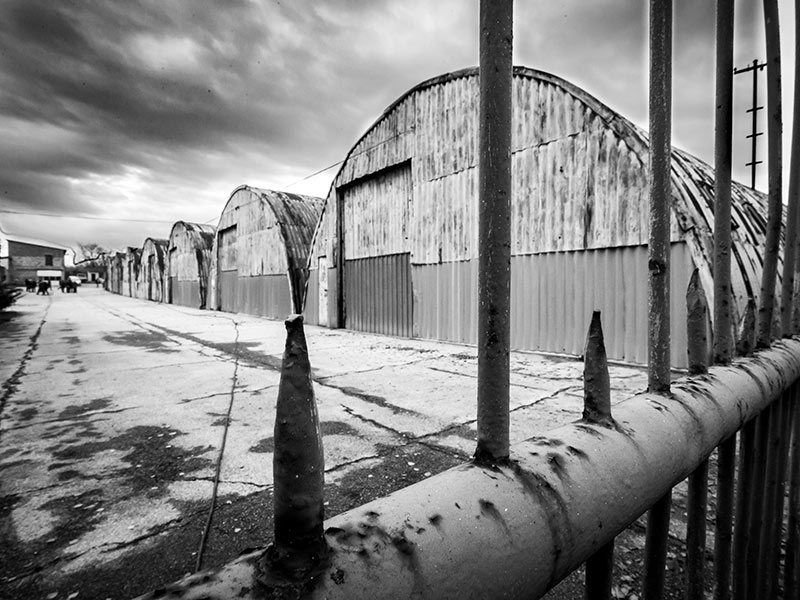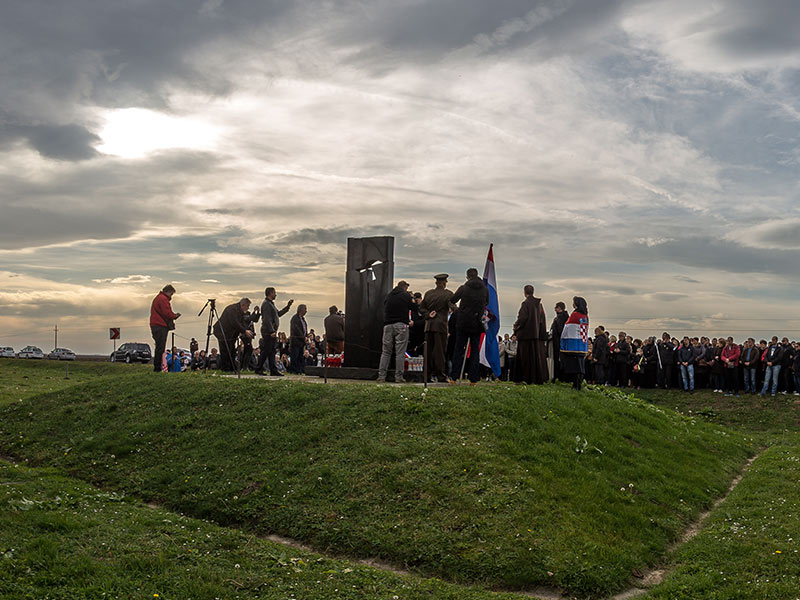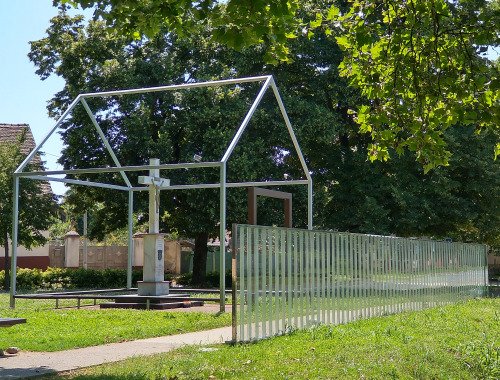

Public Institution “Memorial Center for the Homeland War Vukovar” takes care of maintaining the memory of the Homeland War, preserving the memorial sites and educating the students about the historical importance of the war events.
2nd of January 1992
Sarajevo Ceasefire
On 2nd of January 1992, Sarajevo Ceasefire was signed, agreement on a complete ceasefire in Croatia (Vance Plan) and the arrival of the United Nations in the occupied territories. On the Croatian side, it was signed by Defense Minister Gojko Susak, and on behalf of the JNA General Andrija Raseta. Sarajevo Ceasefire came into force on 3rd of January at 18 o’clock and marked the end of the first stage of Homeland War.
15th of January 1992
The Republic of Croatia International Recognition Day
The European Union (Austria, Belgium, Denmark, France, Greece, Italy, Luxemburg, the Netherlands, Germany, Portugal, Spain and the Great Britain) recognised the Republic of Croatia as an independent and sovereign state on 15th January 1992.
15th of January 1998
The Peaceful Reintegration of the Croatian Danube Region
The Peaceful Reintegration of the Croatian Danube Region started 15th January 1996 and ended 15th January 1998. During that process occupied territories of eastern Slavonia, Baranja and western Srijem were returned into the Republic of Croatia constitutional order.
22nd of January 1993
Operation Maslenica
Operation Pirate, publicly known as Operation Maslenica, started 22nd January and ended 27th January 1993. The part of the Velebit range and the Zadar hinterland was liberated and a link between northern and southern Croatia, interrupted since September 1991, was established.
25th of January 1991
What is the Truth About the HDZ Arming of Croatia
On 25th of January 1991 Croatian television aired a show “What is the Truth About the HDZ Arming of Croatia”. The show was prepeared by the Counter-Intelligence Service “JNA” in order to intorduce a state of emergency, which would legalise and legitimise actions of the JNA.
17th of February 1994
Anniversary of the death of Damir Tomljanović Gavran
February 17 marks the anniversary of the death of Damir Tomljanović Gavran, the legendary commander of the 2nd Infantry Battalion 1 GbR. (Tigers). Training Centre of Guard Airborne Infantry opened on 26th of July 1994. in Šepurine next to Zadar was named in his honor.
1st of March 1991
Pakrac Rebellion
The Pakrac Rebellion, a date some consider to be the beginning of the Homeland War because it is the first armed conflict of the Croatian military forces and Serbian rebels. Croatian police officers prevented the plan of Serbian rebels aiming to occupy Pakrac and make it the center of SAO Krajina for western Slavonia.
10th of March 1991
Day of Croatian Defenders from Vukovar
Anniversary of the first line-up of unarmed detachments in Bogdanovci.
24th of March 1992
Organization for European Security and Cooperation
Croatia became a member of Organization for European Security and Cooperation.
31st of March 1991
Bloody Easter
The Special Units of the Croatian MI returned Plitvice National Park under the supervision of legal police forces. In an armed conflict with Serbian terrorists a policeman Josip Jovic was killed. He was the first Croatian victim of the war who fought to preserve the territorial integrity and constitutional order of Croatia.
22nd and 23rd of April 1990.
First multiparty elections in Croatia
These are the dates of the first multiparty elections in Croatia which were won by the Croatian Democratic Union (HDZ).
28th of April 1991
“Spiders”
On 28th of April 1991, the Fourth guard brigade ZNG RH “Spiders” was founded.
29th of April 1991
“Mustelidae”
On 29th of April 1991, the Third guard brigade ZNG RH “Mustelidae” was founded.
1st of May 1995
Anniversary of the beginning of the military operation Flash
By the 4th of May, western Slavonia and Posavina were liberated – the UN Sector Wapad (about 600 km2), and highway Zagreb – Lipovac was placed under the supervision of Croatian forces.
2nd of May 1991
Anniversary of the of the massacre in Borovo Selo
After imprisoning two and wounding two Croatian policemen the day before, Serbian terrorists killed 12 and wounded 8 Croatian policemen in Borovo Selo near Vukovar. Croatian police officer Franko Lisica was killed in Polači near Zadar on the same day.
2nd of May 1995
Anniversary of the the death of Rudolf Perešin
Rudolf Perešin is one of the most famous Croatian Air Force pilots. He is remembered mostly for his words: “I am a Croatian, I can not and I will not shoot at my own people”, which he uttered after he defected to Austria by JNA plane. After returning to Croatia, Rudolf Perešin became the commander of the first hunter squadron. Perešin and his squadron conducted a number of combat flights in all actions and operations of the Croatian Army, and defended Zagreb and the Croatian airspace. During Operation Flash on May 2nd 1995 by Stara Gradiska his MiG was hit. Two years later his remains were handed over to his family. He was buried at The Mirogoj Cemetery in Zagreb. He was posthumously awarded the rank of Brigadier. The name of the legendary Croatian pilot is proudly carried by the Aeronautical Technical School in Velika Gorica, and the Air Force school in Zadar, since 1998.
2nd and 3rd of May 1995
Rocket Attacks on Croatian Cities
As a retaliation to Operation Bljesak, the Serbian leadership commanded the rocket attack on Croatian cities. The capital of Zagreb was attacked, in which cluster bombs hit the children’s hospital, the gymnasium, the Academy of Dramatic Art and other civilian objects. Seven people were killed and 176 civilians were wounded.
13th of May 1990
The beginning of the decommissioning of the Yugoslav sports league
Due to the extensive riots at the stadium and the conflicts between Croatian and Serbian sports fan, Yugoslavia’s first soccer league match between Dinamo and Crvena zvezda was interrupted, marking the beginning of the decommissioning of joint Yugoslav sports liga. After the “milicija” (the police) intervened only towards the Croatian fans, footballer Dino Zvonimir Boban, the future captain of the Croatian national team, physically opposed the police repression.
14th of May 1991
Weapons Confiscated to Croatia
According to the Order of the Federal Secretariat for National Defense from Belgrade, within the next ten days, the Armed Forces of Territorial Defense confiscated weapons and placed them in the JNA warehouses
15th of May 1991
“Thunders”
On 15th of May 1991, the Second guard brigade ZNG RH “Thunders” was founded.
18th of May 1992
Scorched Land
This day marks the anniversary of the start of military action “Scorched Land” that Croatian army started on the Southern battlefield in order to free Dubrovnik.
19th of May 1991
Croatian independence referendum
At referendum on the future status of the Republic of Croatia, 83.56% of the population (from 3,652,225 voting shares) turned out; 93.24% (2,845,521) of the citizens who voted opted for independence and sovereignty of the Croatian and against remaining in Yugoslavia was 92.18% of voters.
22nd of May 1992
Croatia became a member of the UN
Anniversary of Croatian entrance as 178 member in the organization of the United Nations.
28th of May 1991
Armed Forces Day and the Day Croatian Ground Forces
The anniversary of the first line-up of the National Guard (ZNG) in the NK Zagreb Stadium in Kranjčevićeva Street.
30th of May 1990
Statehood Day
Anniversary of the constitution of the first democratically elected multi-party Croatian Parliament.
30th of May 1994
Croatian kuna
New Croatian currency was released in circulation – HRK.
25th of June 1991
Independance Day
Croatian Parliament passed the Declaration of the Sovereignty and Independence of the Republic of Croatia and so began the process of association of the Socialist Federal Republic of Yugoslavia.
27th of June 1991
Destruction the red Fiat
Osijek citizen Branko Breškić parked his car on the road to protest the demonstration of JNA power on the streets of Osijek. Army tanks overran the Fiat completely destroying it.
1st of July 1992
Liberation operation “Tiger”
This day marks the anniversary of the Liberation operation “Tiger” of the Croatian Army, which goal was to free Dubrovnik.
5th of July 2007
Anniversary of the death of Marko Babic
This day marks the anniversary of the deaths of Marko Babic, Deputy Commander of Defense Postions in Borovo, and deputy Blago Zadro. Colonel Marko Babic organized a highly successful anti-tank missiles at the the Trpinjska Road, especially antitank platoons “Yellow Ants” and “Desert Rats”, which destroyed the tanks of the JNA (mention the number of 14 tanks). With several fellow soldiers he managed to break out of the occupied Vukovar. He died from a stroke and was buried at the Memorial Cemetery of the Homeland War in Vukovar in 2007.
7th of July 1991
Exile of Croatians from Ćelije
Serbian paramilitary units exiled Croatians from the East Slavonian village Ćelije. The village was then robbed and burned.
7th of July 1992
Death of Andrija Andabak
Andrija Andabak is a legendary defender of Nustar and Vinkovci frontline. Andrija Andabak destroyed 32 enemy armor (30 tanks and 2 carriers) and was posthumously promoted to the rank of Major. Recognition awarded by the Croatian Army for destruction of three or more enemy armored vehicles was named in Andabak’s honor. Andrija Andabak (born 1956 in Split) was called “tank hunter”, a fighter with “maljutka”, and he was an infallible archer. His war story began in June 1991 in the 3rd Guard Brigade. A total numver of armored vehicles he destroied or disabled is 32, including 30 tanks (14, T-84, 16 M-55), one APC and one conveyor.
8th of July 2008
Death of Kata Šoljić
July 8 marks the anniversary of the death of Kata Šoljić, mother of four killed soldiers and heroine of the Homeland War, the symbol of suffering and courage of Croatian mothers in the Homeland War. In the Homeland War she lost four sons: Ivo, Niko, Mijo and Mate. The media named her Mother Courage, making her a symbol of suffering and courage of Croatian mothers.
25th of July 1990
The SRH Parliament adopted amendments to the Constitution
Adjective “socialist” was removed from the state name, new (“historical”) emblem and flag were established, and the names of state duties were changed (President of the Presidency becomes president, the Executive Board of the Parliament – Government, Republican Secretary – Minister).
26th of July 1991
Death of Mile Blažević Ćađe
Mile Blažević Čađe is a Croatian police officer who was killed in Struga Banska when he girded himself with explosives and thrown himself at the improvised armored truck full of rebel Serbs. In this venture he had help from Željko Filipović, a police officer from Zagreb. With his act he saved the townspeople who were held as a “human shield” by rebel Serbs. According to the pastor Janko Bunić, this act allowed other residents to withdraw.
1st of August 1991
The Dalj Massacre
In the following days, Croatians were exiled from Erdu, Dalj and Aljmaš.
4th of August 1995
The beginning of the military-police operation Storm
This day marks the beginning of the Military operation Storm, when the Croatian forces freed occupied Croatian territory by August 7 in northern Dalmatia, Lika, Banovina and Kordun (7940 km2).
4th of August 1995
Death of Predrag Matanović
Predrag Matanovic was the wartime commander of the 2nd Guards Brigade. He was killed in the operation “Storm” at the entrance to Petrinja, as commander of the 2nd Battalion, leading his unit in the attack on one of the directions of the attack the 2nd Guards Brigade “Thunders”. After the war, Petrinja barracks was called by his name, and it used to house his 2nd Guards Brigade.
5th of August 1995
Victory and Homeland Thanksgiving Day and the Day of Croatian Defenders
Remembrance to the city of Knin liberation in a military-police operation “Oluja” (“Storm”).
5th of August 1990
Establishment the first armed unit in Republic of Croatia
This day marks the anniversary of the organization of the first armed forces in the Republic of Croatia, the beginning of the course “First Croatian Policeman”. The Ministry of Internal Affairs formed a first police brigade (about 1,700 members), the core of the future Croatian Army.
10th of August 1991
The death of Gordan Lederer
HTV’s cameraman Gordan Lederer was killed by enemies gun fire in Banovina. He was one of the first victims among cameramen and reporters in Homeland War. His shots of Banija Dawns symbolize the opposition of Croatian defenders in the first days of Serbian aggression.
14th of August 1992
The Day of Camp Detainees
Anniversary of the largest exchange of Croatian Camp Detainees detained in Serbian camps in Nemetin
17th of August 1990
Log revolution
The so-called “Log revolution”, in the area of Knin, Benkovac and Obrovac, was organized to block traffic directed by rebel Serbian population and Croatian police attempted to restore order and ensure peace, but was prevented by the JNA.
25th of August 1991
Beginning of the Battle of Vukovar
The Battle of Vukovar started with an open attack of the JNA.
29th of August 1991
Anti-war protests of citizens at Kresimir Square in Zagreb
At a large peace-rally at Kresimir Square in Zagreb in front of the Headquarters of the 5th Military District in Zagreb was between 100 and 150 thousand people. It was held in solidarity with the mothers gathered at bodem the love, the peace movement and the return of their sons from the JNA.
8th of October 1991
Croatian Parliament Day
Parliament adopted a decision on whether to secede from Yugoslavia. They proclaimed the independence of the Croatia. Because of the air raids, session of the Croatian Parliament was held in the basement of the building of Oil and Gas Company (INA). Parliament argued that three month deferral of the Constitutional decision of 25 June 1991 expired, and made a decision on whether to secede from Yugoslavia and become independence: the Republic of Croatia, together with other republics and autonomies, terminated all state and legal relations at the basis of which they formed Yugoslavia.
9th of September 1993
Operation Medak Pocket
Croatian army and police liberated villages Počitelj, Čitluk and Divoselo (about 225 km2). In retaliation the army RSK throw missiles at Gospic.
20th of September 1991
Death of Luke Andrijanić
On 24 August 1991 Luka hit the two JNA aircrafts type “Super Galeb”, which attacked the positions of National Guard on the silo Đergaj. Two days later, Luka and his team, which included Marjan Balic, Antun Bekčević and Zvonimir Hincak, situationed at the water tower, shot down two aircrafts of JNA: MiG-21 and G-fourth.
21st of September 1991
Both! Both! Both went down!
Šibenik air defense destroys two enemy aircrafts during the defense of the city.
21st of September 1991
General Headquarters of the Croatian Army
By the Decision of Croatian President Franjo Tudjman, General Headquarters of the Croatian Army was founded. The first chief was General Anton Tus.
25th of September 1991
Day of 204th Vukovar Brigade
5th of October 1992
“Hawks”
On 5th of October 1992, the Fifth guard brigade ZNG RH “Hawks” was founded.
7th of October 1991
Rocket attacks on Ban’s Court
JNA aircrafts rocketed the Ban’s Court at center of the city, where Croatian President Franjo Tudjman, the president of the Presidency of Yugoslavia, Stjepan Mesic and Prime SIV Yugoslavia, Ante Markovic had a meeting.
9th of October 1995
Death of Andrija Matijaš Pauk
In the battles of Mrkonjic Grad, as deputy commander of the 4th Guard Brigade, Major General Andrija Matijaš Pauk was killed. He was one of the legendary commanders of the Croatian army in the Homeland War.
16th of October 1991
Deaths of Blago Zadro and Alfred Hill
In the battles for the defense of Vukovar, Blago Zadro, a legendary commander of the defense postions and Major Alfred Hill, a company commander of the Military Police 204th Vukovar Brigade, were killed. Army colleges were named after them: Command and Staff College Blago Zadro and Training Center of Military Police Major Alfred Hill.
25th of October 1991
I am Croatian and I will not shoot at my own people!
Pilot Rudolf Perešin fled from the JNA (Yugoslav Air Force) with his MIG 21, and landed at airport in Klagenfurt, Austria. He was killed in early May 1995 at flight mission in the military action “Flash” as a commander of the 1st Hunting Squadron of the Croatian Air Force.
30th of October 1991
Beginning of the liberation operation Hurricane
Almost all of Western Slavonia was liberated, 21 Serb strongholds were successfully neutralized. All of Papuk was liberated, from Orahovica to Daruvar, and mountain Ravna Gora. Voćin, Lipik and a full range of villages were released.
31st of October 1991
Beginning of the liberation operation Otkos
Croatian military units liberated the area of Bilogora (approximately 270 km2) and created the conditions for the offensive actions in the direction of Papuk and Psunj.
31st of October 1991
Humanitarian convoy Libertas sailed in Dubrovnik
The convoy was led by the president of the Presidency of Yugoslavia Stjepan Mesic and Croatian Prime Minister Franjo Gregurić, and carried humanitarian aid to besieged Dubrovnik.
5th of November 1990
“Tigers”
On 5th of November 1990, the First guard brigade ZNG RH “Tigers” was founded.
12th of November 1995
The Erdut Agreement
The Republic of Croatia signed an agreement with the rebel Serbs from the eastern Slavonia and western Sirmium on the peaceful reintegration of these regions at constitutional order of the Republic of Croatian.
18th of November 1991
Remembrance Day for Homeland War Victims and Remembrance Day for the Victims of Vukovar and Skabrnja
Organized resistance of the Croatian defenders ceased. The Battle of Vukovar (25 August – 18 November 1991) was crucial for the defense of Croatia, and Vukovar became a symbol of Croatian resistance to Serbian aggression.
19th of November 1991
The end of organized resistance of Croatian defenders in Borovo.
20th and 21st of November 1991
The mass killings
Mass killings of wounded soldiers and civilians from the Vukovar hospital at Ovcara.
Siniša Glavašević and reporter from Radio Vukovar were killed. He was born in Vukovar in 1960, where he finished elementary and high school. He finished the study of comparative literature and librarianship in Sarajevo. He was the editor of Croatian Radio Vukovar and war correspondent. After the JNA and the Chetniks occupied Vukovar, he was taken from the Vukovar hospital. In 1996, he was exhumed and identified from the Mass Grave Ovcara.
22nd of December 1990
Adoption of the Croatian Constitution
Parliament passed the Constitution of the Republic of Croatia, which defined Croatia as a unitary and indivisible, democratic and social state.
